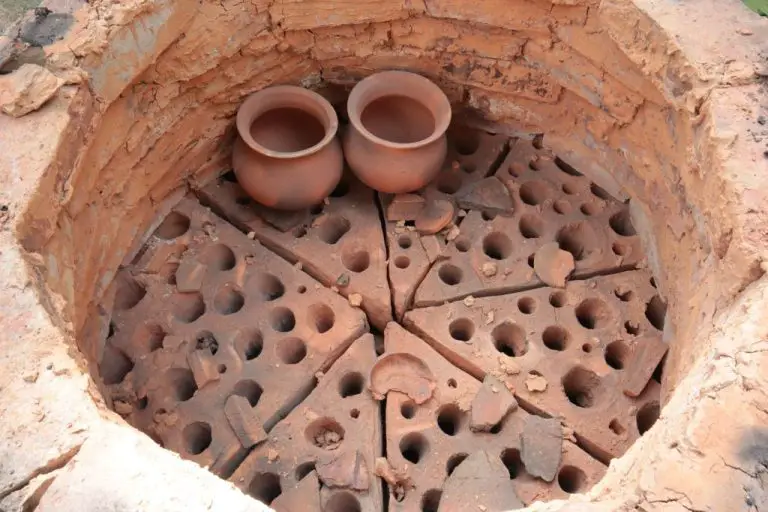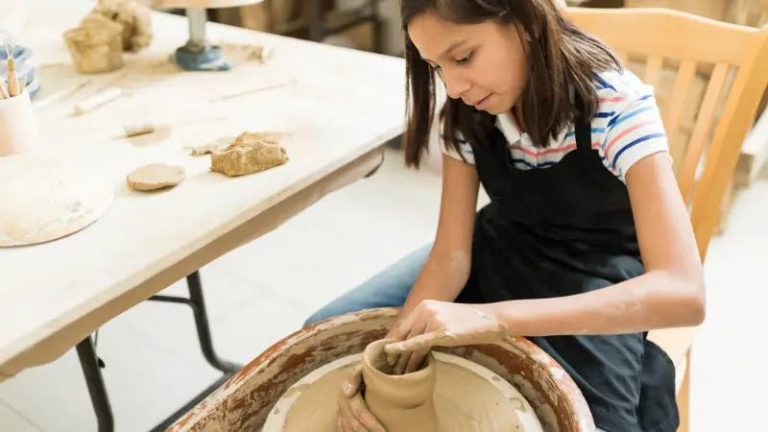Is Clay Color Brown Or Gray?
Clay is a type of soil that is made up of extremely small particles, typically less than 0.002 millimeters in size. It is formed over long periods of time from the gradual chemical weathering of rocks. According to the Dr. Darrin Lew’s Organic Pollutants website, “Clay is composed of minerals, such as aluminum silicate, magnesium silicate, and iron silicate. It also contains water that gets trapped in the spaces between particles.” The small size of the particles gives clay unique properties that make it useful for a variety of applications including pottery, ceramics, and construction materials.
Common Clay Colors
Clay comes in a wide variety of natural colors, ranging from gray and brown to red, white, and yellow. The specific color depends on the composition and mineral content of the clay. Some of the most common clay colors include:
Brown – Brown clay gets its color from iron oxide content. Higher iron levels result in deeper brown and red hues. Common brown clays include terracotta and earthenware.
Gray – Gray clay has lower iron content and higher levels of minerals like quartz and feldspar. Kaolin clay is a common light gray clay used for porcelain. Dark gray clays like stoneware contain more impurities.
Red – Red clay acquires its bright color from large amounts of iron oxide. Red earthenware clays are very common. Adding lower iron clays can mute the red into pink or orange.
White – White clays like kaolin/china clay derive their color from low impurity levels. White clay fires to a bright white finish.
Yellow – Yellow clay contains iron oxides combined with calcium or magnesium, resulting in vibrant yellows and ochres. Yellow ochre clay is commonly used for ceramics.
What Makes Clay Brown or Gray
The color of clay is primarily determined by its iron oxide content and the temperature at which it is fired. Clays with higher iron oxide contents tend to fire to darker earth tones like brown, red, or gray. The iron oxide undergoes chemical changes during firing that influence the final color.
Browns and grays result when iron oxide minerals like hematite or magnetite are present. As the clay is fired, these minerals break down and spread iron ions throughout the clay body, leading to earthy brown and gray hues. Higher firing temperatures result in more complete breakdown and diffusion of iron oxide, creating darker shades of brown/gray.
For example, stoneware clays that fire to a brown or gray color at cone 6 may turn a rich chocolate brown or charcoal gray when fired to cone 10. The higher temperature drives more oxidation of iron, intensifying the color. Subtle variations in clay chemistry and kiln atmosphere during firing also affect the final brown/gray shades.
In contrast, clays low in iron oxide tend to fire lighter, to white, buff, or pale colors. Kaolin clays often lack iron impurities, firing white unless other minerals are added. So iron oxide content and firing temperature are key factors determining brown and gray clay colors.
Brown Clays
Brown clays get their color from having high amounts of iron oxide in their mineral composition. Iron oxide is a compound that contains iron and oxygen atoms. When iron oxide is present in large quantities in clay, it gives the clay a brown, rusty color. Some common brown clays include brown stoneware clay and brown earthenware clay.
Brown clays tend to have lower firing temperatures than other colored clays. The iron oxide allows the clay to vitrify (become hard and glass-like) at lower kiln temperatures. Many brown clays reach maturation between 1832°F and 2102°F (1000°C and 1150°C), compared to higher temperature clays that fire between 2192°F and 2370°F (1200°C and 1300°C). The lower firing range makes brown clays popular for handbuilding and modeling clay bodies.
Sources:
https://www.etsy.com/nz/market/brown_clay
Gray Clays
Gray clays have relatively low iron oxide content compared to other colored clays. They often contain more silica and flux minerals like feldspar and dolomite. The lack of iron oxides is what prevents gray clays from turning red or brown when fired at high temperatures (Peterson, 2022).
Gray clays can be divided into two main types – light gray and dark gray clay. The light gray clays tend to have higher kaolin content while the dark gray clays contain more impurities like iron and organic matter (Jones, 2015). Dark gray clays usually require firing at higher temperatures, sometimes up to 1200°C or more to fully vitrify and achieve their final hardened gray color.
Some common examples of gray clays include kaolin, ball clay, stoneware clay and fire clay (CeramicsToday.com, 2021). These clays are valued for their high fusion point, allowing them to be fired at very high temperatures to create durable ceramic ware. The gray color provides a neutral backdrop that can be easily decorated or glazed over.
Gray clays are mined in many locations globally, notably in the southeastern United States, United Kingdom, Germany and China (MineralsEducationCoalition.org, 2022). Their popularity in ceramic production stems from the smooth, even firing performance and light color that doesn’t bleed or distort other hues.
Red Clays
Red clays are rich in iron oxide and get their distinct red color from being fired at high temperatures between 2,372°F and 2,552°F. According to [a href=”https://planterresource.com/product-category/terracotta-planters/basic-red-clay/”]Planter Resource[/a], red clay pottery has been popular for centuries thanks to its durability and beautiful terra cotta color. When clay contains a high percentage of iron oxide, it turns red when fired in a kiln. The longer the clay is fired and the hotter the kiln temperature, the redder the finished clay will become. Red clays are commonly used to produce terra cotta pottery, tiles, bricks, and other ceramic items that are known for their iconic red-orange hue.
White Clays
White clays contain very low amounts of iron oxide, which gives clay its reddish hue. As the iron oxide content decreases, the clay body lightens in color. Porcelain clays and kaolin clays have extremely low iron oxide levels, resulting in their bright white appearance.
According to this article, the lack of iron oxides allows white clays like porcelain and kaolin to be fired to very high temperatures while maintaining their white color. However, small amounts of impurities can cause white clays to fire with a buff or cream tint.
Some potters find that their white clay bodies develop a buff tone during firing, as discussed in this forum. This buffing effect seems to happen more often in gas kilns rather than electric kilns.
To achieve a true white finish, it’s important to use high purity clay with minimal iron oxide content and fire in an electric kiln. Careful control of firing temperatures and atmosphere is also necessary.
Yellow Clays
Yellow clays contain moderate amounts of iron oxide, which gives them their characteristic yellowish hue (Blanco et al.). The iron oxide content is lower than in red clays, but higher than in white clays. Yellow clays can exhibit colors ranging from pale yellow to deep orange. The depth of the color depends on factors like the specific mineral composition, presence of other elements, and firing temperature.
Some common minerals found in yellow clays include limonite, goethite, and hematite. Limonite tends to produce yellowish brown colors, while goethite leads to a brighter yellow. Hematite contributes more orange and red tones. The concentration and combination of these iron oxide minerals affect the final color.
Typical sources of yellow clay include deposits in China, Europe, and the Americas. Certain regions in the United States and Brazil are well-known for their yellow clay deposits and brick production (www.alibaba.com/showroom/yellow-clay-brick.html). When fired at high temperatures, yellow clays develop a rich, deep orange color that is popular for bricks, pottery, and ceramics.
Clay Color Variations
Even within a single type of clay, there can be considerable variation in color. This is due to differences in mineral content, the presence of organic matter, and the firing temperature used.
For example, a red earthenware clay may range from a bright orange-red to a very deep burgundy red depending on the iron oxide content. Higher iron levels produce a deeper, richer red. Meanwhile, subtle changes in organic carbon can shift the tone from warm to cool.
Stoneware clays also exhibit a wide palette – from very light gray or buff colors to dark blue-grays and browns. Variations in mineral composition and firing temperature impact the final stoneware color. Ironbearing minerals produce gray and brown tones.
Even white porcelain clays show some color variation, from pure whites to slightly warm or cool undertones. The purity and makeup of the clay body affects the whiteness achieved.
So in summary, clay color is quite complex even within a category like “red clay” or “white clay”. Skilled ceramicists learn to control colors by meticulously sourcing their clay materials and mastering firing techniques.
Conclusions
In summary, the color of clay depends on its mineral composition and the presence of impurities. The most common clay colors are brown, gray, red, white, and yellow. Brown clay gets its color from iron oxide, while gray clay contains carbon compounds. Red clay has high iron oxide content, white clay lacks iron and organic matter, and yellow clay contains sulfur or limonite minerals. Even within these broad categories, clays can exhibit a wide range of shades and mottling due to natural variations in mineral content across deposits. While clay deposits often have a predominant color, examining a clay sample up close usually reveals an intricate mixture of tones and patterns. The diversity of clay colors is a testament to the complex geologic processes that form these important Earth materials.





